
Earl of Gosford is a title in the Peerage of Ireland. It was created in 1806 for Arthur Acheson, 2nd Viscount Gosford.

Lord Napier, of Merchistoun, is a title in the Peerage of Scotland. It was created in 1627 for Sir Archibald Napier, 1st Baronet. Earlier that year, he already held the Napier Baronetcy, of Merchistoun in the County of Midlothian, created in the Baronetage of Nova Scotia. The titles remained united until 1683, when the Baronetcy became dormant. It was revived in the early 19th century and is now held by another branch of the Napier family. Between 1683 and 1686, the Lords of Napier also held the Nicolson Baronetcy, of Carnock in the County of Stirling, and since 1725 the Scott Baronetcy, of Thirlestane in the County of Selkirk, both baronetcies created in the Baronetage of Nova Scotia. The latter one is held till today. Additionally, the tenth Lord was created Baron Ettrick, of Ettrick in the County of Selkirk in the Peerage of the United Kingdom on 16 July 1872.

There have been three baronetcies created for persons with the surname Booth, one in the Baronetage of England and two in the Baronetage of the United Kingdom. The 1916 creation remains extant, the 1835 creation became extinct in 1896 and the 1611 baronetcy has been dormant since 1797. The senior line of the first creation was elevated to the peerage as Baron Delamer and Earl of Warrington.
There have been four baronetcies created for persons with the surname Leslie, one in the Baronetage of Nova Scotia, one in the Baronetage of Ireland, one in the Baronetage of Great Britain and one in the Baronetage of the United Kingdom. Three of the creations are extant as of 2010.
There have been two baronetcies created for persons with the surname Bates, both in the Baronetage of the United Kingdom. As of 2014 both creations are extant.

There have been nine baronetcies held by people with the surname Nugent, four in the Baronetage of Ireland and five in the Baronetage of the United Kingdom. Six of the creations are extinct, while three are extant.

There have been three baronetcies created for members of the Blakiston family of Blakiston, County Durham, two in the Baronetage of England and one in the Baronetage of Great Britain. One creation is extant as of 2008.

There have been seventeen baronetcies for persons with the surname Stewart, ten in the Baronetage of Nova Scotia, one in the Baronetage of Ireland and six in the Baronetage of the United Kingdom. See also Steuart baronets, Henderson-Stewart baronets, MacTaggart-Stewart baronets and Stewart-Clark baronets.
There have been five baronetcies created for persons with the surname of White, one in the Baronetage of Great Britain and four in the Baronetage of the United Kingdom. The baronets include Blagdon in the County of Northumberland, Tuxford and Wallingwells in the County of Nottingham, Cotham House in Bristol, Salle Park in the County of Norfolk, and Boulge Hall in the County of Suffolk.
There have been eight baronetcies created for persons with the surname Graham, two in the Baronetage of Nova Scotia, two in the Baronetage of England, one in the Baronetage of Great Britain and three in the Baronetage of the United Kingdom.
There have been four baronetcies created for persons with the surname Barlow, one in the Baronetage of England and three in the Baronetage of the United Kingdom.
The Brooksbank Baronetcy, of Healaugh Manor, in the parish of Healaugh, in the West Riding of the County of York, is a title in the Baronetage of the United Kingdom. It was created on 15 September 1919 for Edward Brooksbank. He was a Justice of the Peace and a Deputy Lieutenant for the West Riding of Yorkshire. He was succeeded by his grandson, the second Baronet. He was a Colonel in the Yorkshire Yeomanry and also served as a justice of the peace and as a Deputy Lieutenant of the East Riding of Yorkshire. Currently, the title is held by his son, the third Baronet, who succeeded in 1983.
There have been four baronetcies created for persons with the surname Child, two in the Baronetage of England and two in the Baronetage of the United Kingdom.

There have been nine baronetcies created for persons with the surname Cooper, one in the Baronetage of England, one in the Baronetage of Ireland and seven in the Baronetage of the United Kingdom.

There have been two baronetcies created for persons with the surname Duckworth, both in the Baronetage of the United Kingdom.

There have been two baronetcies created for persons with the surname Barrow, one in the Baronetage of Great Britain and one in the Baronetage of the United Kingdom.

There have been six baronetcies created with the surname of Leigh: two in the Baronetage of England, one in the Baronetage of Ireland, one in the Baronetage of Great Britain and two in the Baronetage of the United Kingdom. The only creation remaining extant is that of Altrincham, while another is dormant.

The Murray, later MacGregor of MacGregor Baronetcy, of Lanrick in the County of Perth, is a title in the Baronetage of Great Britain. It was created on 3 July 1795 for John Murray. He was a member of the Scottish MacGregor clan. This branch of the family had been forbidden to wear their own surname by King James VI, the only instance of this in British history. The ban was revoked in 1661 by King Charles II but restored during the reign of William and Mary. It was finally repealed in 1774. However, it was not until 1822 that the family obtained Royal licence to use the family surname. The second Baronet was a colonial administrator and served as Governor of Dominica, Antigua, Barbados and Trinidad. Sir Evan MacGregor, third son of the second Baronet, was Permanent Secretary to the Admiralty. The sixth Baronet was a Brigadier in the Scots Guards. The MacGregors of MacGregor are also the Chiefs of Clan Gregor.
There have been three baronetcies created for persons with the surname Hewett, one in the Baronetage of England and two in the Baronetage of the United Kingdom.

There have been four baronetcies created for persons with the surname Bruce, two in the Baronetage of Nova Scotia and two in the Baronetage of the United Kingdom. Two of the creations are extant as of 2010.












